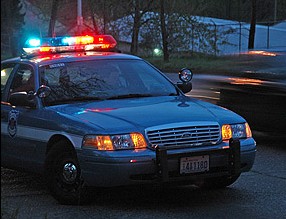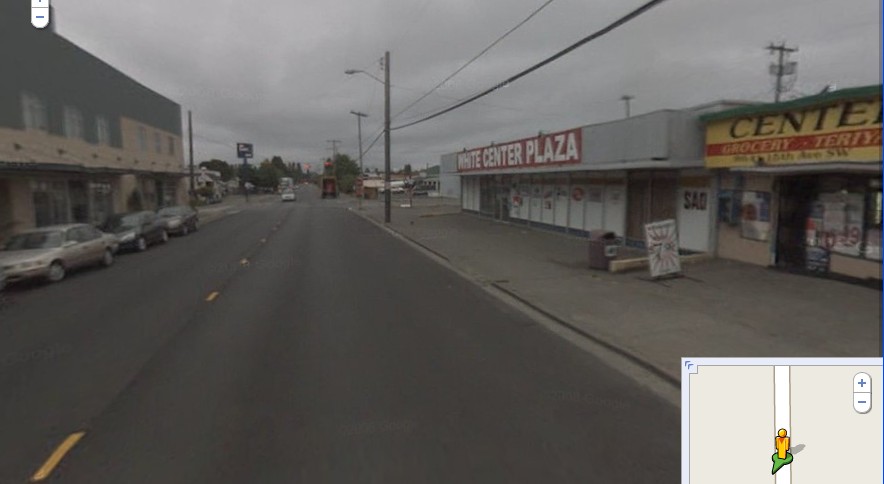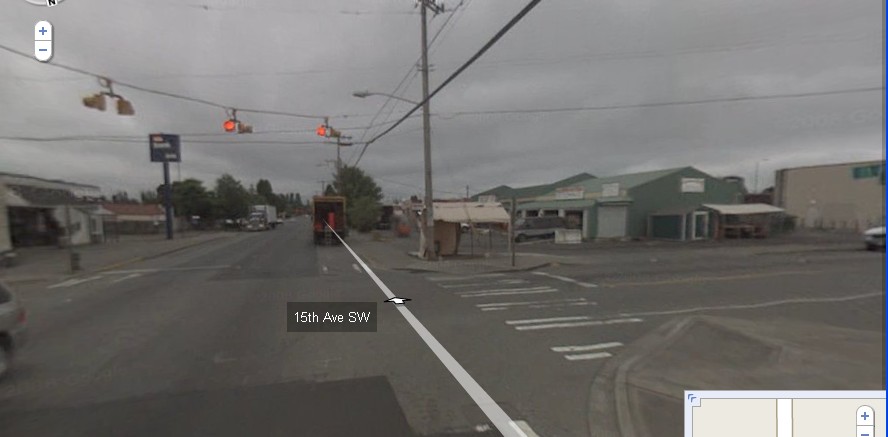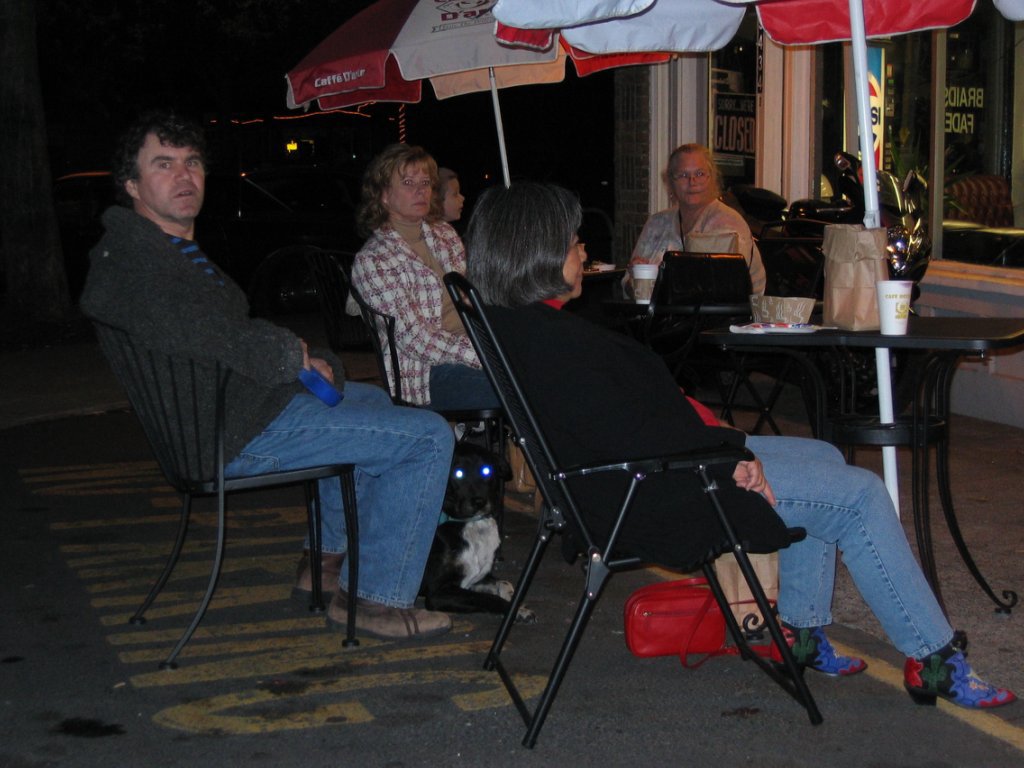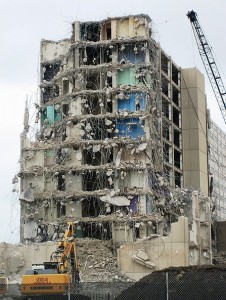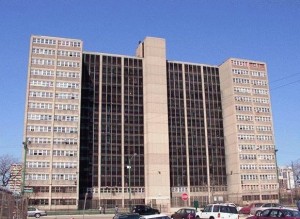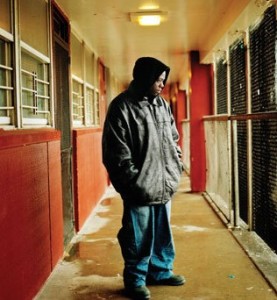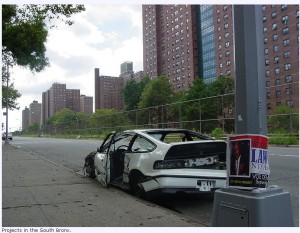Just talked to Sgt. John Urquhart of the King County Sheriff’s Office to find out why a search was under way around 16th/SW 116th – turns out one man was shot, another grazed by a bullet, on SW 119th. Three people have been arrested, no other suspects are being sought, and everybody involved knew each other, according to Sgt. Urquhart – the search that you’re seeing if you’re in the area involves deputies looking for the gun, which hasn’t yet been recovered.
SPD to White Center: “It’s the County’s Problem”
March 18th, 2009 Ricardo Posted in Businesses, Crime, Safety, White Center, White Center news 9 Comments »
Yesterday was St. Patrick’s Day, so the chronic alcoholics, that live on the streets, felt emboldened. Two drunks wondered down 16th Ave. SW, malt liquor in hand (no bags). Clearly having imbibed a good deal already, one of the pair starts screaming at the top of his lungs. Concerned that a fight was about to break out between these two drunks, I called 911 and explained that there were two intoxicated men, drinking malt liquor and being belligerent. The dispatcher asked for description and said he would “call it in.”
My friend and I waited outside of the cafe and placed wagers on whether SPD would respond at all and if so would it be within the hour. “These calls are just one step above noise complaints on their radar,” he said. One of the drunks finished his liquor and flung the 20 oz can like a baseball. The other one continued to nurse his beer. Finally, about a half hour later a Seattle Police Department patrol car shows up with two officers. Not bothering to get out of the car they pull up to the individual with the can of malt liquor in his hand. “Toss it out,” they direct, although he had already started draining the can as he saw the patrol car approach. He flings his can to the ground. “Now move along,” says the officer. The drunks get up and start heading south towards Roxbury.
My friend approaches the patrol car and indicates he wants to talk to them. The police officers look bothered. He tells them that the other fellow had just tossed his can on top of the roof of building. “So?” came the reply from the officer, who had by now exited the car. “Well, we have lots of problems with these chronic drunks and we are concerned that nothing is being done to rid the area of them.”
“Look buddy, it’s not my issue. I can cite him for public intoxication, but that’s just a small fine.” We do not mention that he could have checked their ids and checked for outstanding warrants.
“But they are just going to get another round of malt liquor and continue to blight the area.”
The officer hems and haws and says, “they’re gone ok. Buddy, we gotta go.”
And as the two drunks cross Roxbury into unincorporated King County, the officer looks over and says, “look, they’re the County’s problem now.” And with those parting words, the officer gets in his squad car and drives away.
The Worst Blocks in White Center
March 11th, 2009 Ricardo Posted in Crime, Neighborhoods, White Center, white center community safety coalition 12 Comments »
I generally try not to dwell on the issue of crime in White Center because, on the whole, I think WC gets an undeserved bad rep on this issue. The place has really cleaned up and there are now some very clean stretches where even petty vagrancy will not be found. Such, however, is not the case for the three blocks of 15th Avenue SW just south or Roxbury. Here you will find what White Center used to look like 15 years ago. Vagrants, thugs, drug dealers and chronic alcoholics own these blocks. On any given night (or day) you will see roving bands of miscreants plying their wares. Whether it be the sale of black tar heroin, public drunkenness or just vagrants looking to rifle any car window left open. I know the Sheriff’s Department considers this a high crime zone, as I have both talked to them and seen them on patrol. More, however, needs to be done.
The area suffers these problems because of some structural issues relating to lack of citizen surveillance. The DSHS building that occupies the block just south of Bartells’ is an architectural crime against humanity. The designers of the DSHS building (formerly a Safeways) should be indicted in the Criminal Cout at the Hague. It seems no effort was spared to make this into an insult to the community. The entrance to the building faces the parking lot and has no sight of anything on the street. The back walls all face towards the community creating an architectural dead zone; precisely what you don’t want when trying to integrate into a neighborhood (and create public safety). The hidden spaces created by the building provide sleeping spaces for the homeless and the vagrants. And the dead zone allows all manner of activity to go undetected.
Few of the business in this area have street level views (shops that front sidewalks). As such, the shop owners, even if they were inclined to keep on eye on matters, cannot see what is going on. It does not help that many of the businesses are run by first generation immigrants, who have some level of distrust for the police. As well, many are not accustomed to the concept of community policing. All this adds up to a three block free-for-all for criminals and miscreants. I will be adding pictures of some of these folks, including at least one who is registered sex offender, obviously using his “homeless” status to keep from registering.
Suffice it to say, that until this last stretch of bad seeds is cleaned up, White Center will continue labor under the unfortunate appellation of Rat City.
Beware of counterfeit money
March 11th, 2009 Ricardo Posted in Businesses, Crime, White Center Comments Off on Beware of counterfeit money
Just learned that three teenage kids went to a restaurant last night and tried to pass off a counterfeit $50 and a $20 as legitimate bills. The cashier became suspicious when one of them tried to pay for a single drink with the $50. Both bills were checked with the marker and proved to be fakes. Be careful.
Sheriff’s Office seeks help solving Boulevard Park home invasion
March 4th, 2009 Tracy Posted in Boulevard Park, Crime, White Center news Comments Off on Sheriff’s Office seeks help solving Boulevard Park home invasion
From Sgt. John Urquhart at King County Sheriff’s Office:
On March 3, 2009 at about 8.30 PM a home located in the 11000 block of 8th Ave S was invaded and robbed by three armed suspects. The suspects ransacked the house while holding the occupants at gunpoint. The preliminary investigation indicates the suspects were after money and drugs. They left in what was described as a tan newer Cadillac taking with them an undetermined amount of cash, 2 shotguns and other property. The suspects are described as a white male and 2 Hispanic males all in their mid to late twenties. They were wearing black stocking hats, black sweatshirts and dark jeans. The suspects were all armed with handguns.
Detectives are seeking the public’s assistance with any information that might assist them with their investigation.
Update: Prosecutor can’t make it tonight after all
February 26th, 2009 Tracy Posted in Crime, King County, white center community safety coalition, White Center news Comments Off on Update: Prosecutor can’t make it tonight after all
Just heard from from Dan Donohoe at the office of King County Prosecuting Attorney Dan Satterberg: He says Satterberg has a family emergency and has to cancel his planned appearance at tonight’s White Center/South Delridge Community Safety Coalition meeting, but will reschedule. (However, the law/justice reps who are usually on hand at the meeting do include a prosecutor’s-office rep.) Everything else planned for the meeting, including updates on local crime trends and nuisance spots, is on as usual, 6 pm, St. James Place, 9421 18th SW.
King County Prosecuting Attorney to speak to White Center/South Delridge Community Safety Coalition
February 22nd, 2009 Tracy Posted in Crime, King County, white center community safety coalition, White Center news Comments Off on King County Prosecuting Attorney to speak to White Center/South Delridge Community Safety Coalition
Just posted at partner site West Seattle Blog: Prosecuting Attorney Dan Satterberg — who has longtime White Center ties and lives in nearby Normandy Park — is the guest at this Thursday night’s White Center/South Delridge Community Safety Coalition meeting; read about it here.
White Center Crime Watch: Deputies seek Lucky 7 robber
February 19th, 2009 Tracy Posted in Crime, White Center news Comments Off on White Center Crime Watch: Deputies seek Lucky 7 robber
The King County Sheriff’s Office sent this news release today:
The help of the public is needed to catch a robber who hit the Lucky 7 store twice in less than a two week period, and may have robbed a store in Seattle as well.
The Lucky 7 incidents occurred on January 27th and February 7th, at 1:40 PM and 8:15 AM respectively. The store is in White Center at 9618 – 4th Ave SW.
In both robberies the suspect violently pushed the 71 year-old female clerk to the ground then went to the cash register and stole cash and lottery tickets. No gun or other weapon was seen.
The suspect is described as an Asian male, about 5’ 2” or 5’ 3” tall, around 135 lbs, clean cut and 18 to 19 years old. He wore a NY Yankees baseball hat, and in one of robberies a hoody as well.
In the first robbery the man was seen fleeing the scene in a silver, 2-door, Mercedes or BMW.
If anyone has information about these crimes or knows the suspect they are asked to call the King County Sheriff’s Office at (206) 296-3311, or 9-1-1.
Here’s one of several images shared by KCSO (more to come) – the robber hopping the counter in one of the heists (not a big or clear photo, but best they have):

As we have elaborated on partner site West Seattle Blog, this same robber may be linked to a heist at a West Seattle gas station weekend before last (read more here).
How Cafe Rozella Changed a Small Corner of the World
February 7th, 2009 Ricardo Posted in Businesses, Crime, Fun, White Center 9 Comments »

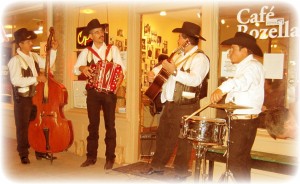
Although descriptions of White Center often include the adjective, “gritty,” the reality is that the neighborhood has, in recent years, changed considerably. Not long ago, prostitutes flaunted their wares throughout the area, drug markets operated openly, drunkards stumbled from tavern to tavern and ruffians roamed the area like extras in a Mad Max movie. As Herb, the owner of Central Heating on Delridge, put it, the stretch from his business on Cambridge to Cafe Rozella was a freeway of drugs and prostitutes. I, who have seen some rough neighborhoods, would not step out of my car on the stretch of 16th Ave south of Roxbury. As far, as I was concerned, this was a no-man’s land of losers and predators. I am not sure how the area became so blighted but part of the reason lies in its netherworld as a piece of unincorporated King County. In many ways it was the lawless wild west.
White Center was changing before we decided to open Cafe Rozella in 2004. King Country Sheriff’s Deputy, Steve Cox was well underway in his campaign to clean up the neighborhood. The community had been up in arms against the criminal element for some time.
I grew up in the south side of El Paso, Texas, where biculturalism is a norm. As well, there were some pretty rough areas and you had to hold your own in a fight. So when Leiticia and I looked at White Center as a location for a traditional coffee house, one that would honor the best traditions of the European gathering place, we were not put off by the rich medley of cultures. To the contary, we embraced the immigrant communities who were opening up markets, restaurants, Pho shops, fruit stands, taquerias and carnicerias. This melange of people were in the process of changing the character of White Center.
In 2003, we scouted out a location for our cafe. After much searching, we found a lovely gem of a building sitting unadorned in the heart of White Center. We decided that the Rozella Building would be perfect for what we had in mind. The Rozella Building was built by Italian immigrants and named after Patriarch’s daughters. Good kharma there.
As we took possession and started the demolition before the build-out, we started to get a taste of the old White Center. Every morning, as we got to work, we would find used condoms, needles, malt liquor cans, and other paraphernalia of the sordid in front of the building. A resident of the apartments upstairs, told us that four people had died in the aparments in the last year, mostly from acute alchohol intoxication. Doug, from Center Tool Rental informed us that his alarm went off so many times, he was getting sick of being fined by the police who often arrived after the miscreants had left. At least two of the upstairs apartments were notorious drug dens and homes for alcoholic denizens looking for a place to pass out. The laundry room was used by prostitutes to take care of their clients. And the gangbangers regularly parked in front of the building, hip hop blasting, cold stares at my crew of workers. Yes, this was going to be a project.
As patrons of the cafe know, we have an outdoor sidewalk cafe with tables and chairs. Drunkards saw the outdoor cafe as just another place to squat while they downed their cans of malt liquor. When you are as large as I am, it usually doesn’t take much convincing to get these guys to move on. But occassionally, one would mouth off and refuse to leave. I found it effective to grab their cans of liquor and squash them. A couple of times they would lunge at me and I would push them into the cement. This eventually discouraged vagrancy.
The prostitutes usually showed up on the weekends. I would take out my digital camera and say, “hey, how’d you like to be on the web?” The pictures were emailed to the Sheriff.
The gangbangers were a little more difficult. Lucky for us, Deputy Cox was quick to respond with a couple of extra deputies. “Ricardo, you want me to move these guys out?” he would ask. But by this point, the sight of three patrol cars was enough to scatter them like roaches in light.
More pernicious still were the dealers upstairs. They had a good gig going and they were not about to let it go — easily. I shot pictures of their customers, and of the dealers and passed them along to Steve Cox. Still, these guys were obstinate. Even friendly visits by Cox and his deputies would not convince them to shut down. One of them was especially mean and violent and he not only threatened me but also that big rock of a man Steve Cox. Weed and Seed folks talked to the landlord and finally convinced him to start removal actions. The landlord would invariably ask me to serve the legal papers as he was too frightened to do it himself. A couple of times, Deputy Cox and his deputies had me go do a knock, as they searched for cons with outstanding warrants. It was a rush.
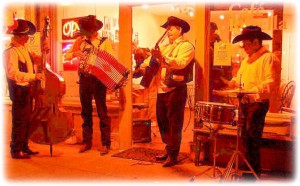
During this time we had the support of the community, including Russell Parks, Betsy Harris, Peggy Weiss, Melinda Bloom and the weed and seed folks, amongst others.
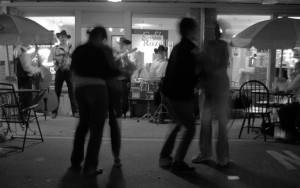

But what really changed the course was the cultural events that we began to sponsor. Shortly after opening, we had a Brazil night and a Mexican Independence Day celebration. For the latter, we hired a wonderful conjunto band from South Park. The place rocked. People were dancing outside of the cafe on a Friday and Saturday night. Nobody had seen anything like this in White Center. It was a blast.
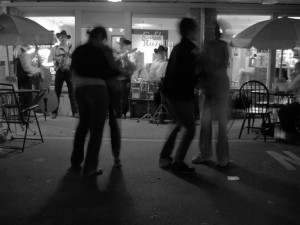
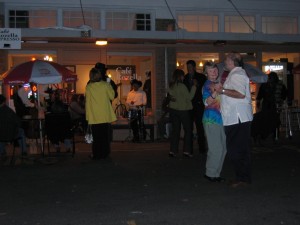
During the summer we started having at least one weekly musical performance in front of the cafe. Where once the place was littered with vagrants, prostitutes, drunks and dope dealers, we had families and children enjoying the music, frolicking and dancing under the stars. Surprisingly, there was resistance from some of the old timers in the business community. But the community loved it. We followed up with poetry readings, a writers’ group, a conversation cafe and other cultural affairs. Things changed and the continue to change.
White Center Community Safety Coalition meeting report #1: Good news and bad news
January 23rd, 2009 Tracy Posted in Crime, white center community safety coalition, White Center news Comments Off on White Center Community Safety Coalition meeting report #1: Good news and bad news
We’ll bring you two reports on news from last night’s White Center/South Delridge Community Safety Coalition meeting, because there’s PLENTY to report. For starters, though, a quick update on what King County Sheriff’s Deputy Jeff Hancock reported on area crime in the month since the group’s last meeting: No burglaries; only one robbery, and it involved “two people who knew each other”; two felony assaults — one in front of Brewsky’s that left the victim with “13 staples to the head,” according to Deputy Hancock, who added “The victim and suspect were back drinking beer together (yesterday)” — the other involved “a group of homeless people attacking another homeless person with sticks.” He also reported a gang-related “drive-by shooting” in which nobody was hit or hurt – 11 rounds fired at a “gang member’s house” just off Roxbury on 11th SW (county side) last Saturday night. Car-related crime was busier – three car prowls in the area, and, the really big stat – 14 car thefts in the past month in the unincorporated area, 9 of those in the White Center “Weed and Seed” area. Deputy Hancock called this a “huge spike” and said KCSO has contributed a detective to a special area Task Force that will be working on the car-theft problem. More news from the CSC meeting later today.
Tonight: White Center Community Safety Coalition
January 22nd, 2009 Tracy Posted in Crime, Safety, white center community safety coalition Comments Off on Tonight: White Center Community Safety Coalition
6 pm tonight, it’s the first White Center/South Delridge Community Safety Coalition meeting of the year, St. James Place, 9421 18th SW (map). Previous White Center Now coverage of this group’s meetings is archived here.
White Center neighborhood alert: Garage break-in
January 21st, 2009 Tracy Posted in Crime, Neighborhoods Comments Off on White Center neighborhood alert: Garage break-in
From Alison, who lives near Evergreen High School:
I just discovered that our garage on the far side of our yard has been broken into. Doesn’t look like anything was taken, if the thieves had looked through the window they would have discovered that it looks like a bomb went off in there and its impossible to get past the door. Equally annoying was the fact they ripped the hasp off the door-the padlock was not locked since it got water in it. We don’t keep anything of value in there so it was all for naught on the thieves part. I guess with the way things are people are pretty desperate, but I don’t think tarps and plastic flower pots really fetch much at the pawn shop these days.
King County Sheriff’s Office has burglary-prevention advice online.
White Center woman’s (formerly) accused killer goes free
January 16th, 2009 Tracy Posted in Crime, White Center news Comments Off on White Center woman’s (formerly) accused killer goes free
From the Seattle Times, the man accused of shooting and killing 38-year-old Dar’Rel Miller of White Center at the Federal Way Transit Center a year ago has just been set free, charges dismissed just before his trial was to begin. The Times article doesn’t say why; a P-I story does – quoting a prosecutor’s office spokesperson as saying the man no longer was considered a suspect.
A message from the sheriff
January 6th, 2009 Tracy Posted in Crime, King County Comments Off on A message from the sheriff
As we reported late last fall, some of the most dramatic cuts proposed for King County public-safety services were avoided (the “storefronts” will all stay open, including the ones in White Center and Boulevard Park, for example) – but the budget ax hasn’t quite finished making its cuts yet – so this e-mail message from County Sheriff Sue Rahr may be of interest: Read the rest of this entry »
Police investigate whether West Seattle arrests are linked to robbery spree including White Center holdup
January 4th, 2009 Tracy Posted in Crime, White Center news Comments Off on Police investigate whether West Seattle arrests are linked to robbery spree including White Center holdup
We reported New Year’s Eve that photos and video were out from a recent robbery rampage that included a December holdup at the Lucky Seven in White Center. Early this morning, after a robbery attempt at a West Seattle 7-11, Seattle Police arrested three suspects and are working right now to establish whether they are linked to this series of robberies. Here’s our full report on West Seattle Blog; we will let you know when more information is released.
White Center/West Seattle robbers caught on camera
December 31st, 2008 Tracy Posted in Crime, White Center news Comments Off on White Center/West Seattle robbers caught on camera
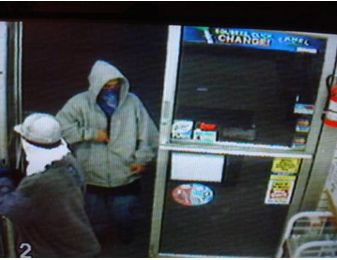
Just posted on partner site West Seattle Blog: An update with video and photos from a series of robberies in South Seattle/White Center/West Seattle including the December 11th holdup at Lucky Seven in WC (one of those photos, shown above). If you have any idea who these robbers are, CrimeStoppers is offering a reward: 800-222-TIPS.
Join your neighbors: White Center Community Safety meeting Thursday night
December 7th, 2008 Tracy Posted in Crime, Safety, white center community safety coalition Comments Off on Join your neighbors: White Center Community Safety meeting Thursday night
One more reminder – last White Center/South Delridge Community Safety Coalition meeting of the year is coming up this Thursday night, different location – 6 pm, Boys and Girls Club, 9800 8th SW (map). (Find previous White Center Now coverage of this group’s meetings is archived here.)
Controversy sparked by trial involving White Center car chase
December 6th, 2008 Tracy Posted in Crime, White Center news Comments Off on Controversy sparked by trial involving White Center car chase
A deputy goes on trial next week, and a flyer urging support for him is sparking controversy – read about it in the Times.
Newspaper analysis says Route 120 is risky for drivers
December 1st, 2008 Tracy Posted in Crime, Metro, Safety Comments Off on Newspaper analysis says Route 120 is risky for drivers
The P-I analyzed driver-attack reports on Metro routes and came up with a “top 10” list that includes Route 120, which runs through White Center (here’s the map). Even one attack is too many, of course, but do take note that the number of attacks that landed Route 120 on this list is … 6 per year.
Greenbridge: The Failure of the Cabrini-Green Model of Public Housing and the Rise of the New Urbanism
November 28th, 2008 Ricardo Posted in Crime, Development, Greenbridge, Real estate, Sustainability, White Center, White Center news Comments Off on Greenbridge: The Failure of the Cabrini-Green Model of Public Housing and the Rise of the New Urbanism
The modern debate on urban housing policy takes as its starting point the post-World War II period when the country invested heavily in developing cities and its suburbs. An outgrowth of the New Deal was the belief that government should ameliorate the problem of housing for those unable to afford the cost of commercial or private housing. The response to the housing problem was a mixture of modernist thought, good intentions, government bureacracy, racial attitudes and local politics. While this subject is vast and would require tomes to fully comprehend it, we are here most concerned with the present moment in Seattle’s urban design and specifically the philosophy behind the Greenbridge Project.
The model against which much of the current thinking pivots is the Chicago Housing Authority and its notorious housing projects such as the Cabrini-Green projects. Witold Rybczynski is an architect and an astute observer, with a sweeping knowledge of urbanism and a very accessible writing style. I was introduced to Rybczynski’s writing when I was designing a home about 15 years ago and happened upon his meditative tome, “The Most Beautiful House in the World.” Rybczynski took Cabrini-Green as a paradigm for the development of urbanism for a 1993 article entitled, “Bauhaus blunders: architecture and public housing – 1950s public housing estates Cabrini-Green, Chicago, Illinois, US“:
Cabrini-Green is but one of the most notorious housing projects known for its drab and sterile concrete towers of festering poverty, rampant crime, trash-strewn stairwells and unmitigated squalor. Most of the towers are now being torn down.
The oldest housing on the site dates from 1941, not long after the Housing Act of 1937 that signaled the first involvement of the federal government in funding housing for what there then called the deserving poor. Frances Cabrini Homes was named after a soon-to-be-canonized Chicago nun, famous for her charitable work, and it was built on the site of a notorious Italian-American slum kown as Little Hell. The new housing consisted of almost 600 dwellings in two- and three-story brick buildings; the total area of the project was relatively small: sixteen acres. The unassuming architecture of these row homes–every dwelling had its own front door on the street–was not substantially different from the popular urban housing then being built by the private sector in the surrounding city. The brick facades even incorporated some decorative elements. The overall design, like that of most prewar public housing projects, is modest but unremarkable; it was taken for granted that poor people would prefer to live lie everyone else. (emphasis added)
Although Cabrini-Green has become synonymous with large government-run slums, they were not the largest or worst of its kind. Hunt D. Bradford has written a concise piece on the Robert Taylor Homes, a larger Chicago Housing project in piece entitled, “What went wrong with public housing in Chicago? A history of the Robert Taylor homes.”
The consensus it that the project tended to congregate poverty and stigmatize the residents. As articulated by Rybczynski:
Although Cabrini-Green occupies almost as much land as the Loop itself, it is not the biggest public housing project in Chicago–that dubious honor belongs to Robert Taylor Homes, said to be the largest public housing project in the world. But Cabrini-Green was the first of the big projects, and it did become a model for how municipal authorities would rehabilitate deteriorated inner-city real estate and provide large amounts of public housing. The solution–bulldoze existing houses and replace them with tall apartment slabs spaced far apart in open parkland (created byh closing off existing streets to make immense “supper-blocks”)–reflected the prevalent social and architectural thinking of the time. As Bauer pointed out, his was not how the majority of Americans really lived–or would choose to live–but the idealistic housing reformers felt that they knew best.
Architects and planners maintained that high-rise buildings were better because they occupied less land, and provided their occupants with sunlight and unobstructed views, but the Chicago Housing Authority was probably attracted to Modern architecture for the same reason that many commercial developers were partial to the designs of Mies van der Rohe–their cost. The truth is that standardized, stripped-down, and undecorated tall buildings can be erected quickly and inexpensively. It is also likely that the plain architecture suited the puritan view of many Americans–and certainly of the housing reformers–who felt that social housing should not be fancy. Soon, utilitarian high-rise apartment towers were accepted as the best solution for public housing.
High-rise slums
However, it was one thing to build apartment towers for the upper-middle-class, as Mies did, and quite another to adopt them as solutions for housing the poor. The well-off have doormen, janitors, repairmen, and baby-sitters; the poor have none of these things. Without restricted access, the lobbies and corridors were vandalized; without proper maintenance, elevators broke down, staircases became garbage dumps, roofs leaked, and broken windows remained unreplaced; without baby-sitters, single mothers were stranded in their apartments, and children roamed unsupervised sixteen floors below. In Cabrini-Green, there were problems with the design of the buildings: To save money, no private balconies or terraces were provided, access galleries and elevator lobbies were left open to the elements (in frigid Chicago!), and despite the lack of air-conditioning, the unshaded apartment windows of the tall buildings faced east and west.
Equally unsuccessful was the overall layout which dispensed with the familiar street and supplanted it with parkland, although what little landscaping there was quickly disappeared and was replaced by beaten dirt and asphalt parking lots. In any case, the open pedestrian spaces were problematic: windy, unappealing, and more crime-prone than conventional streets and sidewalks overlooked by individual homes. In the name of housing the poor, the well-meaning social reformers of the 1950s invented a new type of urbanism, quite foreign to any previous American ideal of city planning. It is hardly surprising that the projects acquired a social stigma. This, as well as crime, drugs, and poor management, explains why today one-third of the apartments at Cabrini-Green remain unoccupied [and are now being demolished].
The reaction to the failure of Cabrini-Green style projects was a return to a style termed, the New Urbanism. Again, Rybczynski:
Which brings us to the Greenbridge, High Point and Holly Park developments in Seattle. Each of these projects reflects completely the philosophy of the New Urbanism and the rejection of the Cabrini-Green model. The development are designed to mix inhabitants of different income levels. As well, the housing is of a human scale with an emphasis on street life, walkability and sustainability. Most critically, these developments aim to look like housing, that anyone, regardless of their station in life, would choose to live in.


